美军导弹和火箭字典
来源:百度文库 编辑:超级军网 时间:2024/04/29 03:39:05
http://www.designation-systems.net/dusrm/index.html
The Directory of U.S. Military Rockets and Missiles presents concise information about all missiles and rockets, which have received a numerical designation in the DOD's joint Designation System for Unmanned Aerospace Vehicles since 27 June 1963.
As can be expected from a site on Designation-Systems.Net, emphasis is on the complete reference to the designations of all missile variants (for explanations of the various designations systems used before 1963, refer to the page about Pre-1963 Designations Of U.S. Missiles And Drones). If possible, a short summary of the developmental and operational history of each missile is also provided, together with one or more photographs. For most missiles, especially the more "popular" ones (like Sidewinder), there exist many more sites on the Web which present more detailed information, more pictures, and more data. However, instead of re-inventing the wheel and/or simply copying-and-pasting information, this site provides an overview of all missile systems, and the reader is encouraged to search elsewhere for further information. Search engines like Google usually yield very good results when searching for missiles by name and/or designation. Because of the dynamic nature of the Web, and the huge amounts of unreliable and/or conflicting information found in it, I will seldom provide links to other websites.
You can either select the missile pages from the Missile Index below, or from this selection box:
AppendixesThe various appendixes to the Directory of U.S. Military Rockets and Missiles cover a selection of unmanned aerospace vehicles, which did not get a missile, rocket or probe designator in the DOD's joint Designation System for Unmanned Aerospace Vehicles.
Appendix 1: Early Missiles and DronesAppendix 1 covers all missiles and drones which received a designation in one of the various pre-1963 systems (see Pre-1963 Designations Of U.S. Missiles And Drones), but which were not redesignated in 1963.
Appendix 2: Modern UAVsAppendix 2 covers the Unmanned Aerial Vehicles designated in new Q-for-UAV series introduced by the Department of Defense in 1997.
Appendix 3: Space VehiclesAppendix 3 covers U.S. Air Force space boosters and satellites, which received a DOD designation in the Designation System for Unmanned Aerospace Vehicles. Older USAF "SLV" (Standard Launch Vehicle) designations are also covered here.
Appendix 4: Undesignated VehiclesAppendix 4 is a non-systematic and incomplete collection of missiles, drones and other unmanned aerospace vehicles, which were operationally used, tested or only studied by the U.S. military services, but did never receive an official designation in any of the designation systems for missiles and UAVs.
Appendix 5: Guided BombsAppendix 5 covers the guided glide bombs in the GBU series.http://www.designation-systems.net/dusrm/index.html
[size=+3]Directory of U.S. Military Rockets and Missiles [size=+1]
Copyright © 2001-2008 Andreas Parsch Search Designation-Systems.Net
[size=80%]Copyright, Terms, Conditions Last updated: 8 September 2008
[size=-1](for update details, see here)
The Directory of U.S. Military Rockets and Missiles presents concise information about all missiles and rockets, which have received a numerical designation in the DOD's joint Designation System for Unmanned Aerospace Vehicles since 27 June 1963.
As can be expected from a site on Designation-Systems.Net, emphasis is on the complete reference to the designations of all missile variants (for explanations of the various designations systems used before 1963, refer to the page about Pre-1963 Designations Of U.S. Missiles And Drones). If possible, a short summary of the developmental and operational history of each missile is also provided, together with one or more photographs. For most missiles, especially the more "popular" ones (like Sidewinder), there exist many more sites on the Web which present more detailed information, more pictures, and more data. However, instead of re-inventing the wheel and/or simply copying-and-pasting information, this site provides an overview of all missile systems, and the reader is encouraged to search elsewhere for further information. Search engines like Google usually yield very good results when searching for missiles by name and/or designation. Because of the dynamic nature of the Web, and the huge amounts of unreliable and/or conflicting information found in it, I will seldom provide links to other websites.
You can either select the missile pages from the Missile Index below, or from this selection box:
Select Missile: AppendixesThe various appendixes to the Directory of U.S. Military Rockets and Missiles cover a selection of unmanned aerospace vehicles, which did not get a missile, rocket or probe designator in the DOD's joint Designation System for Unmanned Aerospace Vehicles.
Appendix 1: Early Missiles and DronesAppendix 1 covers all missiles and drones which received a designation in one of the various pre-1963 systems (see Pre-1963 Designations Of U.S. Missiles And Drones), but which were not redesignated in 1963.
Appendix 2: Modern UAVsAppendix 2 covers the Unmanned Aerial Vehicles designated in new Q-for-UAV series introduced by the Department of Defense in 1997.
Appendix 3: Space VehiclesAppendix 3 covers U.S. Air Force space boosters and satellites, which received a DOD designation in the Designation System for Unmanned Aerospace Vehicles. Older USAF "SLV" (Standard Launch Vehicle) designations are also covered here.
Appendix 4: Undesignated VehiclesAppendix 4 is a non-systematic and incomplete collection of missiles, drones and other unmanned aerospace vehicles, which were operationally used, tested or only studied by the U.S. military services, but did never receive an official designation in any of the designation systems for missiles and UAVs.
Appendix 5: Guided BombsAppendix 5 covers the guided glide bombs in the GBU series.
| [size=+3]Directory of U.S. Military Rockets and Missiles |
| [size=+1] Copyright © 2001-2008 Andreas Parsch |
| Search Designation-Systems.Net [size=80%]Copyright, Terms, Conditions |
| Last updated: 8 September 2008 [size=-1](for update details, see here) |
The Directory of U.S. Military Rockets and Missiles presents concise information about all missiles and rockets, which have received a numerical designation in the DOD's joint Designation System for Unmanned Aerospace Vehicles since 27 June 1963.
As can be expected from a site on Designation-Systems.Net, emphasis is on the complete reference to the designations of all missile variants (for explanations of the various designations systems used before 1963, refer to the page about Pre-1963 Designations Of U.S. Missiles And Drones). If possible, a short summary of the developmental and operational history of each missile is also provided, together with one or more photographs. For most missiles, especially the more "popular" ones (like Sidewinder), there exist many more sites on the Web which present more detailed information, more pictures, and more data. However, instead of re-inventing the wheel and/or simply copying-and-pasting information, this site provides an overview of all missile systems, and the reader is encouraged to search elsewhere for further information. Search engines like Google usually yield very good results when searching for missiles by name and/or designation. Because of the dynamic nature of the Web, and the huge amounts of unreliable and/or conflicting information found in it, I will seldom provide links to other websites.
You can either select the missile pages from the Missile Index below, or from this selection box:
| Select Missile: |
Appendix 1: Early Missiles and DronesAppendix 1 covers all missiles and drones which received a designation in one of the various pre-1963 systems (see Pre-1963 Designations Of U.S. Missiles And Drones), but which were not redesignated in 1963.
Appendix 2: Modern UAVsAppendix 2 covers the Unmanned Aerial Vehicles designated in new Q-for-UAV series introduced by the Department of Defense in 1997.
Appendix 3: Space VehiclesAppendix 3 covers U.S. Air Force space boosters and satellites, which received a DOD designation in the Designation System for Unmanned Aerospace Vehicles. Older USAF "SLV" (Standard Launch Vehicle) designations are also covered here.
Appendix 4: Undesignated VehiclesAppendix 4 is a non-systematic and incomplete collection of missiles, drones and other unmanned aerospace vehicles, which were operationally used, tested or only studied by the U.S. military services, but did never receive an official designation in any of the designation systems for missiles and UAVs.
Appendix 5: Guided BombsAppendix 5 covers the guided glide bombs in the GBU series.http://www.designation-systems.net/dusrm/index.html
[size=+3]Directory of U.S. Military Rockets and Missiles [size=+1]
Copyright © 2001-2008 Andreas Parsch Search Designation-Systems.Net
[size=80%]Copyright, Terms, Conditions Last updated: 8 September 2008
[size=-1](for update details, see here)
The Directory of U.S. Military Rockets and Missiles presents concise information about all missiles and rockets, which have received a numerical designation in the DOD's joint Designation System for Unmanned Aerospace Vehicles since 27 June 1963.
As can be expected from a site on Designation-Systems.Net, emphasis is on the complete reference to the designations of all missile variants (for explanations of the various designations systems used before 1963, refer to the page about Pre-1963 Designations Of U.S. Missiles And Drones). If possible, a short summary of the developmental and operational history of each missile is also provided, together with one or more photographs. For most missiles, especially the more "popular" ones (like Sidewinder), there exist many more sites on the Web which present more detailed information, more pictures, and more data. However, instead of re-inventing the wheel and/or simply copying-and-pasting information, this site provides an overview of all missile systems, and the reader is encouraged to search elsewhere for further information. Search engines like Google usually yield very good results when searching for missiles by name and/or designation. Because of the dynamic nature of the Web, and the huge amounts of unreliable and/or conflicting information found in it, I will seldom provide links to other websites.
You can either select the missile pages from the Missile Index below, or from this selection box:
Select Missile: AppendixesThe various appendixes to the Directory of U.S. Military Rockets and Missiles cover a selection of unmanned aerospace vehicles, which did not get a missile, rocket or probe designator in the DOD's joint Designation System for Unmanned Aerospace Vehicles.
Appendix 1: Early Missiles and DronesAppendix 1 covers all missiles and drones which received a designation in one of the various pre-1963 systems (see Pre-1963 Designations Of U.S. Missiles And Drones), but which were not redesignated in 1963.
Appendix 2: Modern UAVsAppendix 2 covers the Unmanned Aerial Vehicles designated in new Q-for-UAV series introduced by the Department of Defense in 1997.
Appendix 3: Space VehiclesAppendix 3 covers U.S. Air Force space boosters and satellites, which received a DOD designation in the Designation System for Unmanned Aerospace Vehicles. Older USAF "SLV" (Standard Launch Vehicle) designations are also covered here.
Appendix 4: Undesignated VehiclesAppendix 4 is a non-systematic and incomplete collection of missiles, drones and other unmanned aerospace vehicles, which were operationally used, tested or only studied by the U.S. military services, but did never receive an official designation in any of the designation systems for missiles and UAVs.
Appendix 5: Guided BombsAppendix 5 covers the guided glide bombs in the GBU series.
BQM-90
Space Data PWN-12 Super Loki ROBIN
AGM-122 Sidearm.
The Sidewinder Story, 1998 (original article published in "Australian Aviation", April 1994)
(8) Popular Name: Most missiles receive a "popular name" or acronym very early in the planning or development phase. While the name is not part of the official designation, many missiles are almost exclusively referenced by their name, both in the popular press and in official government news releases and documents.
KD6G
AGM-80AChryslerViper (derivative of AGM-12 with inertial guidance; cancelled USAF project)
AIM-120A/B/C/D
JAIM-120A/B/C
CATM-120A/B/C/D
DATM-120ARaytheon (Hughes)AMRAAM (Advanced Medium-Range Air-to-Air Missile)
JAIM-120A/B/C
CATM-120A/B/C/D
DATM-120ARaytheon (Hughes)AMRAAM (Advanced Medium-Range Air-to-Air Missile)
ADM-160A/B/C
DATM-160BNorthrop Grumman (Teledyne Ryan) (ADM-160A)
Raytheon (ADM-160B/C)MALD (Miniature Air-Launched Decoy)
DATM-160BNorthrop Grumman (Teledyne Ryan) (ADM-160A)
Raytheon (ADM-160B/C)MALD (Miniature Air-Launched Decoy)
Directory和Dictionary居然是一个意思,你可以去复习一下小学英语了
MQ-17AMTC TechnologiesSpyHawk
LOCAAS (Low-Cost Autonomous Attack Subsystem). This is a smart submunition currently under development, which could also be regarded as a guided missile of its own. So far, submunitions have usually received BLU-n/B designations, but guided self-propelled submunitions are actually a fairly new concept for which no really appropriate designation categories exist. The GBU (Guided Bomb) designator does not explicitly exclude submunitions, so a GBU-n/B designation could be assigned.Martin Marietta M712 Copperhead (a guided cannon-launched 155mm projectile). The Copperhead has no propulsion of its own, and is regarded as a "projectile" and not a "missile" by the Army. Therefore it received number M712 in the Army's general series for gun projectiles.
Atlas V EELV (Evolved Expendable Launch Vehicle)
2004 editions
[4] Department of Defense: "Model Designation of Military Aircraft, Rockets and Missiles", 7/1964, 1/1965, 7/1965, 1/1970 editions
[5] Department of Defense Missile Nomenclature Records
[4] Department of Defense: "Model Designation of Military Aircraft, Rockets and Missiles", 7/1964, 1/1965, 7/1965, 1/1970 editions
[5] Department of Defense Missile Nomenclature Records
RIM-101A missile proposed in 1974 was also an advanced RIM-7E/H Sea Sparrow derivative, which was cancelled in favor of further RIM-7 development. The RIM-7F was relatively short-lived because further development was cancelled in favor of a ship-launched derivative of the AIM-7M, the RIM-7M (q.v.).
The AIM-7G was a version with a new seeker, developed for the USAF around 1970 for use by the F-111D aircraft. A few YAIM-7G prototype missiles were built, but this version did not enter production.
The RIM-7H was an improved RIM-7E missile better adapted for shipboard use. Above all, it had folding fins to fit into more compact MK 29 launchers (these folding fins were also used on the subsequent RIM-7F/M/P/R versions). Otherwise it was essentially similar to the AIM/RIM-7E and therefore less advanced than the RIM-7F despite its "later" designation suffix. The RIM-7H is the missile used in the NATO Sea Sparrow Missile System (NSSMS) Block I, and production began in 1973.
The next version of the AIM-7 was the AIM-7M, whose main new feature was the new inverse monopulse seeker for look-down/shoot-down capability in a new WGU-6/B (later WGU-23/B) guidance section. There is no evidence of any Sparrow variants officially designated -7J/K/L (although the designation AIM-7J is sometimes associated with the AIM-7E license-built in Japan). Source [2] says that the suffix "M" was deliberately chosen to mean "monopulse", suggesting that suffixes J/K/L were indeed skipped. The monopulse seeker improves missile performance in low-altitude and ECM environments. Other new features of the AIM-7M are a digital computer (with software in EEPROM modules reprogrammable on the ground), an autopilot, and an active fuze. The autopilot enables the AIM-7M to fly optimized trajectories, with target illumination necessary only for mid-course and terminal guidance. The AIM-7M also has a new WDU-27/B blast-fragmentation warhead in a WAU-17/B warhead section. The first firing of a YAIM-7M occured in 1980, and the AIM-7M entered production in 1982.
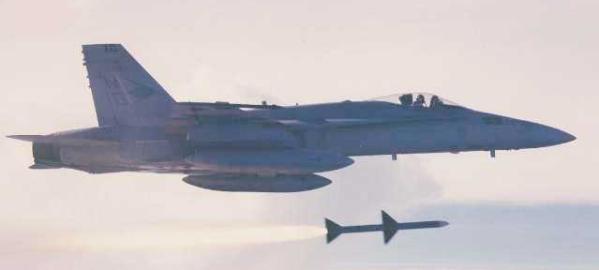 [size=-1]Photo: U.S. NavyAIM-7M/P (exact model unknown)
[size=-1]Photo: U.S. NavyAIM-7M/P (exact model unknown)
The various training versions of the AIM-7M are designated ATM-7M, CATM-7M, DATM-7M, and CAEM-7M for the same purposes as the equivalent -7E versions. The CATM/DATM-7M missiles are also used for training for the later AIM-7P.
The RIM-7M Sea Sparrow is the ship-launched equivalent of the AIM-7M, and its training version is designated RTM-7M. In addition to the 8-cell MK 29 box launcher, the RIM-7M (and the later RIM-7P) missiles can also be fired from MK 41 (AEGIS) and MK 48 VLS (Vertical Launch System) launchers.
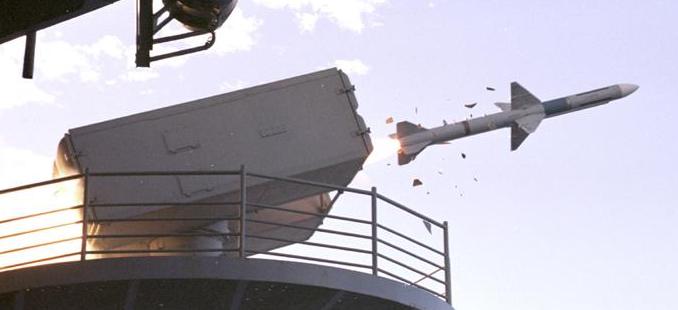 [size=-1]Photo: U.S. NavyRIM-7M
[size=-1]Photo: U.S. NavyRIM-7M
[size=-2]Last Updated: 13 April 2007
The AIM-7G was a version with a new seeker, developed for the USAF around 1970 for use by the F-111D aircraft. A few YAIM-7G prototype missiles were built, but this version did not enter production.
The RIM-7H was an improved RIM-7E missile better adapted for shipboard use. Above all, it had folding fins to fit into more compact MK 29 launchers (these folding fins were also used on the subsequent RIM-7F/M/P/R versions). Otherwise it was essentially similar to the AIM/RIM-7E and therefore less advanced than the RIM-7F despite its "later" designation suffix. The RIM-7H is the missile used in the NATO Sea Sparrow Missile System (NSSMS) Block I, and production began in 1973.
The next version of the AIM-7 was the AIM-7M, whose main new feature was the new inverse monopulse seeker for look-down/shoot-down capability in a new WGU-6/B (later WGU-23/B) guidance section. There is no evidence of any Sparrow variants officially designated -7J/K/L (although the designation AIM-7J is sometimes associated with the AIM-7E license-built in Japan). Source [2] says that the suffix "M" was deliberately chosen to mean "monopulse", suggesting that suffixes J/K/L were indeed skipped. The monopulse seeker improves missile performance in low-altitude and ECM environments. Other new features of the AIM-7M are a digital computer (with software in EEPROM modules reprogrammable on the ground), an autopilot, and an active fuze. The autopilot enables the AIM-7M to fly optimized trajectories, with target illumination necessary only for mid-course and terminal guidance. The AIM-7M also has a new WDU-27/B blast-fragmentation warhead in a WAU-17/B warhead section. The first firing of a YAIM-7M occured in 1980, and the AIM-7M entered production in 1982.
 [size=-1]Photo: U.S. NavyAIM-7M/P (exact model unknown)
[size=-1]Photo: U.S. NavyAIM-7M/P (exact model unknown)The various training versions of the AIM-7M are designated ATM-7M, CATM-7M, DATM-7M, and CAEM-7M for the same purposes as the equivalent -7E versions. The CATM/DATM-7M missiles are also used for training for the later AIM-7P.
The RIM-7M Sea Sparrow is the ship-launched equivalent of the AIM-7M, and its training version is designated RTM-7M. In addition to the 8-cell MK 29 box launcher, the RIM-7M (and the later RIM-7P) missiles can also be fired from MK 41 (AEGIS) and MK 48 VLS (Vertical Launch System) launchers.
 [size=-1]Photo: U.S. NavyRIM-7M
[size=-1]Photo: U.S. NavyRIM-7M[size=-2]Last Updated: 13 April 2007
RIM-162. Until 2001 more than 62000 AIM-7 Sparrow and 9000 RIM-7 Sea Sparrow missiles of all versions have been built.
SpecificationsNotes: Data given by several sources show slight variations. Figures given below may therefore be inaccurate! The AIM-7's range depends heavily on firing parameters and aircraft radar, and the numbers given below are only rough estimates for maximum effective range in head-on engagements.
Data for AIM-7A/B/C/E/F/M/P and RIM-7M/P:
AAM-N-2 (AIM-7A)AAM-N-3 (AIM-7B)AIM-7CAIM-7EAIM-7FAIM-7M/PRIM-7M/PLength3.74 m (147.3 in)3.85 m (151.7 in)3.66 m (144 in)Wingspan0.94 m (37 in)1.02 m (40 in)Finspan0.88 m (34.8 in)?0.81 m (32 in)0.62 m (24.3 in)Diameter0.203 m (8 in)Weight143 kg (315 lb)176 kg (389 lb)172 kg (380 lb)197 kg (435 lb)231 kg (510 lb)SpeedMach 2.5Mach 4Range10 km (5.4 nm)7 km (4 nm)11 km (6 nm)30 km (16 nm)70 km (38 nm)26 km (14 nm)PropulsionAerojet 1.8KS7800 solid rocketRocketdyne MK 38/MK 52
solid rocketHercules MK 58 dual-thrust solid rocketWarhead20 kg (45 lb)30 kg (65 lb) MK 38 continuous rod39 kg (86 lb) MK 71
continuous rod40 kg (88 lb) WDU-27/B
blast-fragmentation
Main Sources[1] Norman Friedman: "US Naval Weapons", Conway Maritime Press, 1983
[2] Norman Friedman: "World Naval Weapons Systems, 1997/98", Naval Institute Press, 1997
[3] Bill Gunston: "The Illustrated Encyclopedia of Rockets and Missiles", Salamander Books Ltd, 1979
[4] Hajime Ozu: "Missile 2000 - Reference Guide to World Missile Systems", Shinkigensha, 2000
[5] Christopher Chant: "World Encyclopaedia of Modern Air Weapons", Patrick Stephens Ltd., 1988
[6] BuAer Instruction 05030.4A: "Model Designation of Naval Aircraft, KD Targets, and BuAer Guided Missiles", Dept. of the Navy, 1958
SpecificationsNotes: Data given by several sources show slight variations. Figures given below may therefore be inaccurate! The AIM-7's range depends heavily on firing parameters and aircraft radar, and the numbers given below are only rough estimates for maximum effective range in head-on engagements.
Data for AIM-7A/B/C/E/F/M/P and RIM-7M/P:
AAM-N-2 (AIM-7A)AAM-N-3 (AIM-7B)AIM-7CAIM-7EAIM-7FAIM-7M/PRIM-7M/PLength3.74 m (147.3 in)3.85 m (151.7 in)3.66 m (144 in)Wingspan0.94 m (37 in)1.02 m (40 in)Finspan0.88 m (34.8 in)?0.81 m (32 in)0.62 m (24.3 in)Diameter0.203 m (8 in)Weight143 kg (315 lb)176 kg (389 lb)172 kg (380 lb)197 kg (435 lb)231 kg (510 lb)SpeedMach 2.5Mach 4Range10 km (5.4 nm)7 km (4 nm)11 km (6 nm)30 km (16 nm)70 km (38 nm)26 km (14 nm)PropulsionAerojet 1.8KS7800 solid rocketRocketdyne MK 38/MK 52
solid rocketHercules MK 58 dual-thrust solid rocketWarhead20 kg (45 lb)30 kg (65 lb) MK 38 continuous rod39 kg (86 lb) MK 71
continuous rod40 kg (88 lb) WDU-27/B
blast-fragmentation
Main Sources[1] Norman Friedman: "US Naval Weapons", Conway Maritime Press, 1983
[2] Norman Friedman: "World Naval Weapons Systems, 1997/98", Naval Institute Press, 1997
[3] Bill Gunston: "The Illustrated Encyclopedia of Rockets and Missiles", Salamander Books Ltd, 1979
[4] Hajime Ozu: "Missile 2000 - Reference Guide to World Missile Systems", Shinkigensha, 2000
[5] Christopher Chant: "World Encyclopaedia of Modern Air Weapons", Patrick Stephens Ltd., 1988
[6] BuAer Instruction 05030.4A: "Model Designation of Naval Aircraft, KD Targets, and BuAer Guided Missiles", Dept. of the Navy, 1958
Copyright © 2003-2008 Jos Heyman
[size=-1](HTML formatting by Andreas Parsch)
Boeing (Rockwell) NS-7 Navstar GPSThe designation NS-7A referred to the Navstar series of navigational satellite also known as Navigational Development Satellite (NDS) and the Global Positioning System (GPS). The satellites were developed for the US Navy by Rockwell and four satellites provided a positional fix with an accuracy of 30 m. It was also made available to civilian users. The 525 kg Navstar satellites were fitted with three rubidium clocks and one caesium clock. They transmitted at 1575.42 MHz for civilian users and at 1227.6 MHz for military users.
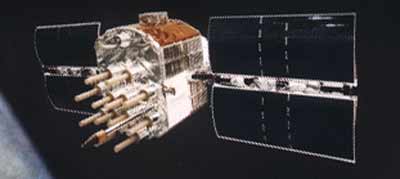 [size=-1]Image: Author's collectionNS-7A
[size=-1]Image: Author's collectionNS-7A
Navstar-1 (1978 020A)
NameIntl. DesignationLaunchRe-entryNotesNavstar-11978 020A22-Feb-1978 Also known as Ops-5111Navstar-21978 047A13-May-1978 Also known as Ops-5112Navstar-31978 093A7-Oct-1978 Also known as Ops-5113Navstar-41978 112A11-Dec-1978 Also known as Ops-5114Navstar-51980 011A9-Feb-1980 Also known as Ops-5117Navstar-61980 032A26-Apr-1980 Also known as Ops-5118Navstar-7---18-Dec-1981---Failed to orbitNavstar-81983 072A14-Jul-1983 Also known as Ops-9794Navstar-91984 059A13-Jun-1984 Also known as USA-1Navstar-101984 097A8-Sep-1984 Also known as USA-5Navstar-111985 093A9-Oct-1985 Also known as USA-10Launch dates of the Navstar series
The Navstar 2 system, designated as NS-7B, was also built by Rockwell. The operational system consisted of 21 satellites. Each 1665 kg satellite was equipped with an atomic clock with an accuracy of 1 second in 300,000 years. The transmissions were at 1575.42 MHz for civilian purposes and 1227.6 MHz for military purposes.
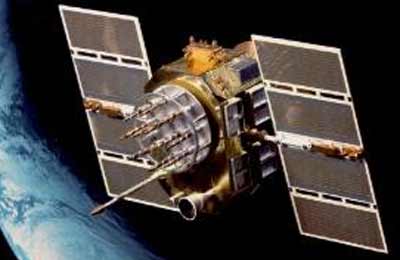 [size=-1]Image: Author's collectionNS-7B
[size=-1]Image: Author's collectionNS-7B
Navstar 2-1 (1989 013A)
NameIntl. DesignationLaunchRe-entryNotesNavstar 2-11989 013A14-Feb-1989 Also known as USA-35Navstar 2-21989 044A10-Jun-1989 Also known as USA-38Navstar 2-31989 064A18-Aug-1989 Also known as USA-42Navstar 2-41989 085A21-Oct-1989 Also known as USA-47Navstar 2-51989 097A11-Dec-1989 Also known as USA-49Navstar 2-61990 008A24-Jan-1990 Also known as USA-50Navstar 2-71990 025A26-Mar-1990 Also known as USA-54Navstar 2-81990 068A2-Aug-1990 Also known as USA-63Navstar 2-91990 088A1-Oct-1990 Also known as USA-64Launch dates of the Navstar 2 series
The Navstar 2A series, designated as NS-7C, was similar to the Navstar 2 series but carried improved instrumentation.
NameIntl. DesignationLaunchRe-entryNotesNavstar 2A-11990 103A26-Nov-1990 Also known as USA-66Navstar 2A-21991 047A4-Jul-1991 Also known as USA-71Navstar 2A-31992 009A23-Feb-1992 Also known as USA-79Navstar 2A-41992 019A10-Apr-1992 Also known as USA-80Navstar 2A-51992 039A7-Jul-1992 Also known as USA-83Navstar 2A-61992 058A9-Sep-1992 Also known as USA-84Navstar 2A-71992 079A23-Nov-1992 Also known as USA-85Navstar 2A-81992 089A18-Dec-1992 Also known as USA-87Navstar 2A-91993 007A3-Feb-1993 Also known as USA-88Navstar 2A-101993 017A30-Mar-1993 Also known as USA-90Navstar 2A-111993 032A13-May-1993 Also known as USA-91Navstar 2A-121993 042A26-Jun-1993 Also known as USA-92Navstar 2A-131993 054A30-Aug-1993 Also known as USA-94Navstar 2A-141993 068A26-Oct-1993 Also known as USA-96Navstar 2A-151994 016A10-Mar-1994 Also known as USA-100Navstar 2A-161996 019A28-Mar-1996 Also known as USA-117Navstar 2A-171996 041A16-Jul-1996 Also known as USA-126Navstar 2A-181996 056A12-Sep-1996 Also known as USA-128Navstar 2A-191997 067A5-Nov-1997 Also known as USA-134Launch dates of the Navstar 2A series
Further improvements to the instrumentation was introduced with the Navstar 2R ("R" for "replenishment") series, which was also designated as NS-7D. Whilst these satellites used the original Rockwell design, they were in fact built by Lockheed Martin. Navstar 2R-M was a "modernised" version (hence the "M") of the 2R series. The series used the remaining eight unlaunched 2R satellites but converted with increased power for existing signals and two new military signals as well as a second civilian signal, along with a redesigned external antenna panel and more efficient transmitters. The mass of the satellites increased by 28 kg to 2073 kg.
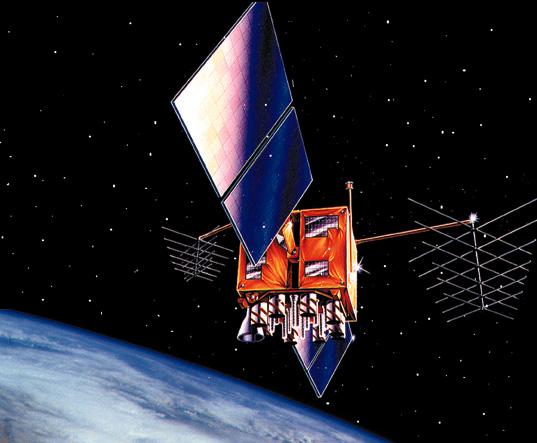 [size=-1]Image: Lockheed MartinNS-7D
[size=-1]Image: Lockheed MartinNS-7D
NameIntl. DesignationLaunchRe-entryNotesNavstar 2R-1---17-Jan-1997---Failed to orbitNavstar 2R-21997 035A23-Jul-1997 Also known as USA-132Navstar 2R-31999 055A7-Oct-1999 Also known as USA-145Navstar 2R-42000 025A11-May-2000 Also known as USA-150Navstar 2R-52000 040A16-Jul-2000 Also known as USA-151Navstar 2R-62000 071A10-Nov-2000 Also known as USA-154Navstar 2R-72001 004A30-Jan-2001 Also known as USA-156Navstar 2R-82003 005A29-Jan-2003 Also known as USA-166Navstar 2R-92003 010A31-Mar-2003 Also known as USA-168Navstar 2R-102003 058A21-Dec-2003 Also known as USA-175Navstar 2R-112004 009A20-Mar-2004 Also known as USA-177Navstar 2R-122004 023A23-Jun-2004 Also known as USA-178Navstar 2R-132004 045A6-Nov-2004 Also known as USA-180Navstar 2R-142005 038A26-Sep-2005 Also known as USA-183Navstar 2R-152006 042A26-Sep-2006 Also known as USA-190Navstar 2R-162006 052A17-Nov-2005 Also known as USA-192Navstar 2R-172007 047A17-Oct-2007 Also known as USA-196Navstar 2R-182007 062A20-Dec-2007 Also known as USA-199Launch dates of the Navstar 2R series
The designation NS-7E refers to the Navstar 2F series of satellites. Boeing (which now owns Rockwell) has received an order to build six against a requirement of 33 by 2012. As it is recognised that over the years that the Navstar 2F series will be launched, technology and needs will change, Boeing has adopted a modular approach which will allow them to meet those changes.
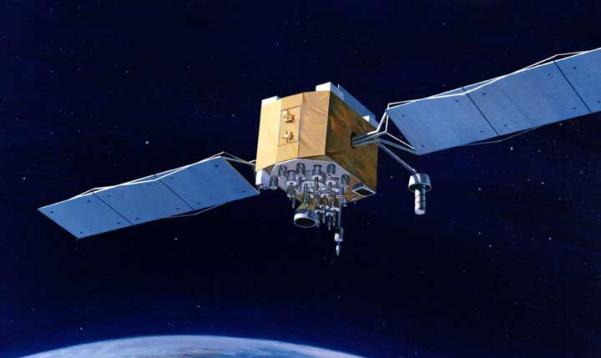 [size=-1]Image: BoeingNS-7E
[size=-1]Image: BoeingNS-7E
Background historyNavigational satellites are essentially radio transmitters of which the orbital positions are known. Through analysing the signals from three satellites, a navigator is not only able to determine his longitude and latitude but also, where appropriate, his altitude.
The early navigational satellites in the Transit series used a radio-Doppler navigation method in which the ship's position was calculated from the observed change in the received frequency of the satellite radio transmission as the satellite passes across the sky. This technique is based on the principle that the orbit of a satellite can be accurately computed by the analysis of the Doppler shift of the radio transmissions by the satellites. The accuracy is, however, limited by the frequency stability of the satellite transmissions and the ability to predict the satellite's orbit between the time it is measured by a ground tracking station and the time the user observed the satellite.
Another method is based on time ranging. Here the user calculates his distance from a satellite by a measurement of the time that the radio signal of the satellite takes to cover the distance to the receiver. To achieve a reasonable accuracy, this method requires three separate satellites and a very accurate clock.
Transit seriesThe early navigational satellites of the United States were of an experimental nature. They were sponsored by the U.S. Navy and were built by RCA. The Transit-1A and -2 series carried two ultrastable oscillators, an electronic clock and four frequency transmitters which operated in the 162/216 MHz and 53/324 MHz bands. Transit-3 carried in addition a small magnetic memory. The Transit-4 series, which was of a different design, was unique in that they carried a Supplementary Nuclear Power (SNAP) source to generate the satellite's power requirements. Transmitters operated at 150/400 MHz. The Transit-5 series satellites were of an octagonal shape and carried dual frequency transmitters as well as a 30 m gravity gradient stabilisation boom. The 5A sub-series were powered by solar cells whilst the 5B sub-series carried a SNAP-9A nuclear power source. The 5C sub-series reverted again to solar cells.
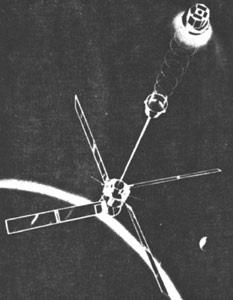 [size=-1]Image: Author's collectionTransit-5C1 (1964 026A)
[size=-1]Image: Author's collectionTransit-5C1 (1964 026A)
NameIntl. DesignationLaunchRe-entryNotesTransit-1A---17-Sep-1959---Failed to orbitTransit-1B1960 γ213-Apr-19605-Oct-1967 Transit-2A1960 η122-Jun-1960 Transit-3A---30-Nov-1960---Failed to orbitTransit-3B1961 η121-Feb-196130-Mar-1961Failed to separate from Lofti-1Transit-4A1961 ο129-Jun-1961 Transit-4B1961 αη115-Nov-1961 Transit-5A11962 βψ119-Dec-196225-Sep-1986 Transit-5A2---5-Apr-1963---Also known as Ops-0804; failed to orbitTransit-5A31963 022A16-Jun-19633-Aug-1990 Transit-5BN11963 038B28-Sep-1963 Transit-5BN21963 049B5-Dec-1963 Transit-5BN3---21-Apr-1964---Failed to orbitTransit-5C11964 026A4-Jun-1964 Also known as Ops-4412Launch dates of the Transit series
[size=-1](HTML formatting by Andreas Parsch)
Boeing (Rockwell) NS-7 Navstar GPSThe designation NS-7A referred to the Navstar series of navigational satellite also known as Navigational Development Satellite (NDS) and the Global Positioning System (GPS). The satellites were developed for the US Navy by Rockwell and four satellites provided a positional fix with an accuracy of 30 m. It was also made available to civilian users. The 525 kg Navstar satellites were fitted with three rubidium clocks and one caesium clock. They transmitted at 1575.42 MHz for civilian users and at 1227.6 MHz for military users.
 [size=-1]Image: Author's collectionNS-7A
[size=-1]Image: Author's collectionNS-7ANavstar-1 (1978 020A)
NameIntl. DesignationLaunchRe-entryNotesNavstar-11978 020A22-Feb-1978 Also known as Ops-5111Navstar-21978 047A13-May-1978 Also known as Ops-5112Navstar-31978 093A7-Oct-1978 Also known as Ops-5113Navstar-41978 112A11-Dec-1978 Also known as Ops-5114Navstar-51980 011A9-Feb-1980 Also known as Ops-5117Navstar-61980 032A26-Apr-1980 Also known as Ops-5118Navstar-7---18-Dec-1981---Failed to orbitNavstar-81983 072A14-Jul-1983 Also known as Ops-9794Navstar-91984 059A13-Jun-1984 Also known as USA-1Navstar-101984 097A8-Sep-1984 Also known as USA-5Navstar-111985 093A9-Oct-1985 Also known as USA-10Launch dates of the Navstar series
The Navstar 2 system, designated as NS-7B, was also built by Rockwell. The operational system consisted of 21 satellites. Each 1665 kg satellite was equipped with an atomic clock with an accuracy of 1 second in 300,000 years. The transmissions were at 1575.42 MHz for civilian purposes and 1227.6 MHz for military purposes.
 [size=-1]Image: Author's collectionNS-7B
[size=-1]Image: Author's collectionNS-7BNavstar 2-1 (1989 013A)
NameIntl. DesignationLaunchRe-entryNotesNavstar 2-11989 013A14-Feb-1989 Also known as USA-35Navstar 2-21989 044A10-Jun-1989 Also known as USA-38Navstar 2-31989 064A18-Aug-1989 Also known as USA-42Navstar 2-41989 085A21-Oct-1989 Also known as USA-47Navstar 2-51989 097A11-Dec-1989 Also known as USA-49Navstar 2-61990 008A24-Jan-1990 Also known as USA-50Navstar 2-71990 025A26-Mar-1990 Also known as USA-54Navstar 2-81990 068A2-Aug-1990 Also known as USA-63Navstar 2-91990 088A1-Oct-1990 Also known as USA-64Launch dates of the Navstar 2 series
The Navstar 2A series, designated as NS-7C, was similar to the Navstar 2 series but carried improved instrumentation.
NameIntl. DesignationLaunchRe-entryNotesNavstar 2A-11990 103A26-Nov-1990 Also known as USA-66Navstar 2A-21991 047A4-Jul-1991 Also known as USA-71Navstar 2A-31992 009A23-Feb-1992 Also known as USA-79Navstar 2A-41992 019A10-Apr-1992 Also known as USA-80Navstar 2A-51992 039A7-Jul-1992 Also known as USA-83Navstar 2A-61992 058A9-Sep-1992 Also known as USA-84Navstar 2A-71992 079A23-Nov-1992 Also known as USA-85Navstar 2A-81992 089A18-Dec-1992 Also known as USA-87Navstar 2A-91993 007A3-Feb-1993 Also known as USA-88Navstar 2A-101993 017A30-Mar-1993 Also known as USA-90Navstar 2A-111993 032A13-May-1993 Also known as USA-91Navstar 2A-121993 042A26-Jun-1993 Also known as USA-92Navstar 2A-131993 054A30-Aug-1993 Also known as USA-94Navstar 2A-141993 068A26-Oct-1993 Also known as USA-96Navstar 2A-151994 016A10-Mar-1994 Also known as USA-100Navstar 2A-161996 019A28-Mar-1996 Also known as USA-117Navstar 2A-171996 041A16-Jul-1996 Also known as USA-126Navstar 2A-181996 056A12-Sep-1996 Also known as USA-128Navstar 2A-191997 067A5-Nov-1997 Also known as USA-134Launch dates of the Navstar 2A series
Further improvements to the instrumentation was introduced with the Navstar 2R ("R" for "replenishment") series, which was also designated as NS-7D. Whilst these satellites used the original Rockwell design, they were in fact built by Lockheed Martin. Navstar 2R-M was a "modernised" version (hence the "M") of the 2R series. The series used the remaining eight unlaunched 2R satellites but converted with increased power for existing signals and two new military signals as well as a second civilian signal, along with a redesigned external antenna panel and more efficient transmitters. The mass of the satellites increased by 28 kg to 2073 kg.
 [size=-1]Image: Lockheed MartinNS-7D
[size=-1]Image: Lockheed MartinNS-7DNameIntl. DesignationLaunchRe-entryNotesNavstar 2R-1---17-Jan-1997---Failed to orbitNavstar 2R-21997 035A23-Jul-1997 Also known as USA-132Navstar 2R-31999 055A7-Oct-1999 Also known as USA-145Navstar 2R-42000 025A11-May-2000 Also known as USA-150Navstar 2R-52000 040A16-Jul-2000 Also known as USA-151Navstar 2R-62000 071A10-Nov-2000 Also known as USA-154Navstar 2R-72001 004A30-Jan-2001 Also known as USA-156Navstar 2R-82003 005A29-Jan-2003 Also known as USA-166Navstar 2R-92003 010A31-Mar-2003 Also known as USA-168Navstar 2R-102003 058A21-Dec-2003 Also known as USA-175Navstar 2R-112004 009A20-Mar-2004 Also known as USA-177Navstar 2R-122004 023A23-Jun-2004 Also known as USA-178Navstar 2R-132004 045A6-Nov-2004 Also known as USA-180Navstar 2R-142005 038A26-Sep-2005 Also known as USA-183Navstar 2R-152006 042A26-Sep-2006 Also known as USA-190Navstar 2R-162006 052A17-Nov-2005 Also known as USA-192Navstar 2R-172007 047A17-Oct-2007 Also known as USA-196Navstar 2R-182007 062A20-Dec-2007 Also known as USA-199Launch dates of the Navstar 2R series
The designation NS-7E refers to the Navstar 2F series of satellites. Boeing (which now owns Rockwell) has received an order to build six against a requirement of 33 by 2012. As it is recognised that over the years that the Navstar 2F series will be launched, technology and needs will change, Boeing has adopted a modular approach which will allow them to meet those changes.
 [size=-1]Image: BoeingNS-7E
[size=-1]Image: BoeingNS-7EBackground historyNavigational satellites are essentially radio transmitters of which the orbital positions are known. Through analysing the signals from three satellites, a navigator is not only able to determine his longitude and latitude but also, where appropriate, his altitude.
The early navigational satellites in the Transit series used a radio-Doppler navigation method in which the ship's position was calculated from the observed change in the received frequency of the satellite radio transmission as the satellite passes across the sky. This technique is based on the principle that the orbit of a satellite can be accurately computed by the analysis of the Doppler shift of the radio transmissions by the satellites. The accuracy is, however, limited by the frequency stability of the satellite transmissions and the ability to predict the satellite's orbit between the time it is measured by a ground tracking station and the time the user observed the satellite.
Another method is based on time ranging. Here the user calculates his distance from a satellite by a measurement of the time that the radio signal of the satellite takes to cover the distance to the receiver. To achieve a reasonable accuracy, this method requires three separate satellites and a very accurate clock.
Transit seriesThe early navigational satellites of the United States were of an experimental nature. They were sponsored by the U.S. Navy and were built by RCA. The Transit-1A and -2 series carried two ultrastable oscillators, an electronic clock and four frequency transmitters which operated in the 162/216 MHz and 53/324 MHz bands. Transit-3 carried in addition a small magnetic memory. The Transit-4 series, which was of a different design, was unique in that they carried a Supplementary Nuclear Power (SNAP) source to generate the satellite's power requirements. Transmitters operated at 150/400 MHz. The Transit-5 series satellites were of an octagonal shape and carried dual frequency transmitters as well as a 30 m gravity gradient stabilisation boom. The 5A sub-series were powered by solar cells whilst the 5B sub-series carried a SNAP-9A nuclear power source. The 5C sub-series reverted again to solar cells.
 [size=-1]Image: Author's collectionTransit-5C1 (1964 026A)
[size=-1]Image: Author's collectionTransit-5C1 (1964 026A)NameIntl. DesignationLaunchRe-entryNotesTransit-1A---17-Sep-1959---Failed to orbitTransit-1B1960 γ213-Apr-19605-Oct-1967 Transit-2A1960 η122-Jun-1960 Transit-3A---30-Nov-1960---Failed to orbitTransit-3B1961 η121-Feb-196130-Mar-1961Failed to separate from Lofti-1Transit-4A1961 ο129-Jun-1961 Transit-4B1961 αη115-Nov-1961 Transit-5A11962 βψ119-Dec-196225-Sep-1986 Transit-5A2---5-Apr-1963---Also known as Ops-0804; failed to orbitTransit-5A31963 022A16-Jun-19633-Aug-1990 Transit-5BN11963 038B28-Sep-1963 Transit-5BN21963 049B5-Dec-1963 Transit-5BN3---21-Apr-1964---Failed to orbitTransit-5C11964 026A4-Jun-1964 Also known as Ops-4412Launch dates of the Transit series
楼主的资料不错很有价值,但可惜全都是英文不过还是值得收藏。:D :L :handshake
图片链接有问题,可以直接上传图片。
楼主一向是好同志!
原帖由 plumage 于 2008-9-25 08:31 发表
图片链接有问题,可以直接上传图片。
不折腾啦.直接去看吧.很多信息.
好东西,就是读起来太累。英语都还给学校了:Q
http://www.verycd.com/topics/263282/
这个帖子很是值得一看
这个帖子很是值得一看
:handshake :handshake :handshake
